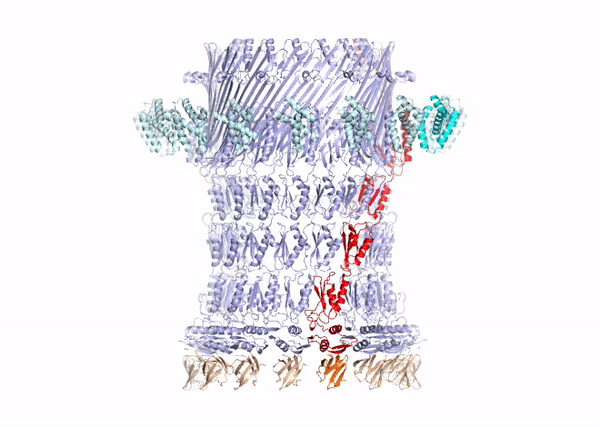Molecular Machines
Klebsiella pneumoniae type II secretion system outer membrane complex comprising the secretin PulD (blue and red), the pilotin PulS (cyan) and PulC HR domain (orange).
At the resolution of around a billionth of a metre, the proteins within living systems are observable as an aggregation of molecular machines, each with unique architecture, chemistry and cellular function. The lab mainly uses a fusion of biochemistry, electron microscopy and X-ray crystallography to understand how these molecular machines work at near atomic resolution. At this scale, the mechanics of basic cellular processes and the aetiology of disease may be understood in detail, thereby providing a platform for technological and medical advance.
Our research broadly focuses on three themes:
i) Bacterial pathogenesis with a particular interest in how bacterial secretion systems initiate and sustain infection. We are interested in showing how the evolutionary related type II secretion system, the type 4 pilus system and the TAD system work at a molecular level with a long-term vision of developing targeted antibiotics against these systems.
ii) Membrane remodelling processes in both bacteria and eukaryotes. We have a particular focus on dynamin and ESCRT-III-like proteins, both of which we discovered in bacteria. These proteins have multiple functions in bacteria ranging from phage resistance to bacterial persistence and membrane stress response in pathogens. Our work has implication for how bacterial evade the immune system and develop resistance to antibiotics.
iii) Method development to grow previously uncultivable bacteria combined with antibiotic discovery. Bacteria are a rich source of useful molecules including antibiotics, antifungals, cancer drugs and immunosuppressants. Consequently, there is significant academic and commercial interest to develop methods that improve the cultivability of bacteria. In turn, the assembly and screening of novel bacterial libraries for bioactive compounds facilitates access to an essentially limitless and untapped chemical reservoir with broad medicinal and biotechnological application.


